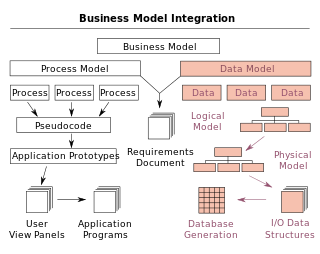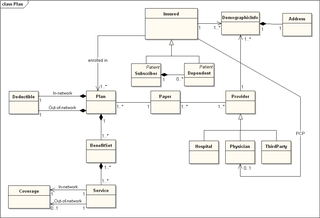
In computing, a database is an organized collection of data or a type of data store based on the use of a database management system (DBMS), the software that interacts with end users, applications, and the database itself to capture and analyze the data. The DBMS additionally encompasses the core facilities provided to administer the database. The sum total of the database, the DBMS and the associated applications can be referred to as a database system. Often the term "database" is also used loosely to refer to any of the DBMS, the database system or an application associated with the database.
A conceptual schema or conceptual data model is a high-level description of informational needs underlying the design of a database. It typically includes only the core concepts and the main relationships among them. This is a high-level model with insufficient detail to build a complete, functional database. It describes the structure of the whole database for a group of users. The conceptual model is also known as the data model that can be used to describe the conceptual schema when a database system is implemented. It hides the internal details of physical storage and targets the description of entities, datatypes, relationships and constraints.

An object–relational database (ORD), or object–relational database management system (ORDBMS), is a database management system (DBMS) similar to a relational database, but with an object-oriented database model: objects, classes and inheritance are directly supported in database schemas and in the query language. In addition, just as with pure relational systems, it supports extension of the data model with custom data types and methods.

A data model is an abstract model that organizes elements of data and standardizes how they relate to one another and to the properties of real-world entities. For instance, a data model may specify that the data element representing a car be composed of a number of other elements which, in turn, represent the color and size of the car and define its owner.

An entity–relationship model describes interrelated things of interest in a specific domain of knowledge. A basic ER model is composed of entity types and specifies relationships that can exist between entities.

Data modeling in software engineering is the process of creating a data model for an information system by applying certain formal techniques. It may be applied as part of broader Model-driven engineering (MDE) concept.

Object–role modeling (ORM) is used to model the semantics of a universe of discourse. ORM is often used for data modeling and software engineering.
A logical data model or logical schema is a data model of a specific problem domain expressed independently of a particular database management product or storage technology but in terms of data structures such as relational tables and columns, object-oriented classes, or XML tags. This is as opposed to a conceptual data model, which describes the semantics of an organization without reference to technology.
Database design is the organization of data according to a database model. The designer determines what data must be stored and how the data elements interrelate. With this information, they can begin to fit the data to the database model. A database management system manages the data accordingly.
Object–relational impedance mismatch is a set of difficulties going between data in relational data stores and data in domain-driven object models. Relational Database Management Systems (RDBMS) is the standard method for storing data in a dedicated database, while object-oriented (OO) programming is the default method for business-centric design in programming languages. The problem lies in neither relational databases nor OO programming, but in the conceptual difficulty mapping between the two logic models. Both logical models are differently implementable using database servers, programming languages, design patterns, or other technologies. Issues range from application to enterprise scale, whenever stored relational data is used in domain-driven object models, and vice versa. Object-oriented data stores can trade this problem for other implementation difficulties.

In software engineering, a domain model is a conceptual model of the domain that incorporates both behavior and data. In ontology engineering, a domain model is a formal representation of a knowledge domain with concepts, roles, datatypes, individuals, and rules, typically grounded in a description logic.
Entity Framework (EF) is an open source object–relational mapping (ORM) framework for ADO.NET. It was originally shipped as an integral part of .NET Framework, however starting with Entity Framework version 6.0 it has been delivered separately from the .NET Framework.
The enhanced entity–relationship (EER) model in computer science is a high-level or conceptual data model incorporating extensions to the original entity–relationship (ER) model, used in the design of databases.
Gerardus Maria "Sjir" Nijssen is a Dutch computer scientist, former professor of computer science at the University of Queensland, consultant, and author. Nijssen is considered the founder of verbalization in computer science, and one of the founders of business modeling and information analysis based on natural language.
NORMA is a conceptual modeling tool that implements the object-role modeling (ORM) method.
Design & Engineering Methodology for Organizations (DEMO) is an enterprise modelling methodology for transaction modelling, and analysing and representing business processes. It is developed since the 1980s by Jan Dietz and others, and is inspired by the language/action perspective
The following is provided as an overview of and topical guide to databases:
Henderik Alex (Erik) Proper is a Dutch computer scientist, an FNR PEARL Laureate, and a senior research manager within the Computer Science (ITIS) department of the Luxembourg Institute of Science and Technology (LIST). He is also adjunct professor in data and knowledge engineering at the University of Luxembourg. He is known for work on conceptual modeling, enterprise architecture and enterprise engineering.

Eckhard D. Falkenberg is a German scientist and Professor Emeritus of Information Systems at the Radboud University Nijmegen. He is known for his contributions in the fields of information modelling, especially object-role modeling, and the conceptual foundations of information systems.
Antony J. (Tony) Morgan is a British computer scientist, data modeling consultant, and Professor in computer science at INTI International University. He is known for his work on (2002) "Business rules and information systems," and the 2010 "Information modeling and relational databases," co-authored with Terry Halpin.








